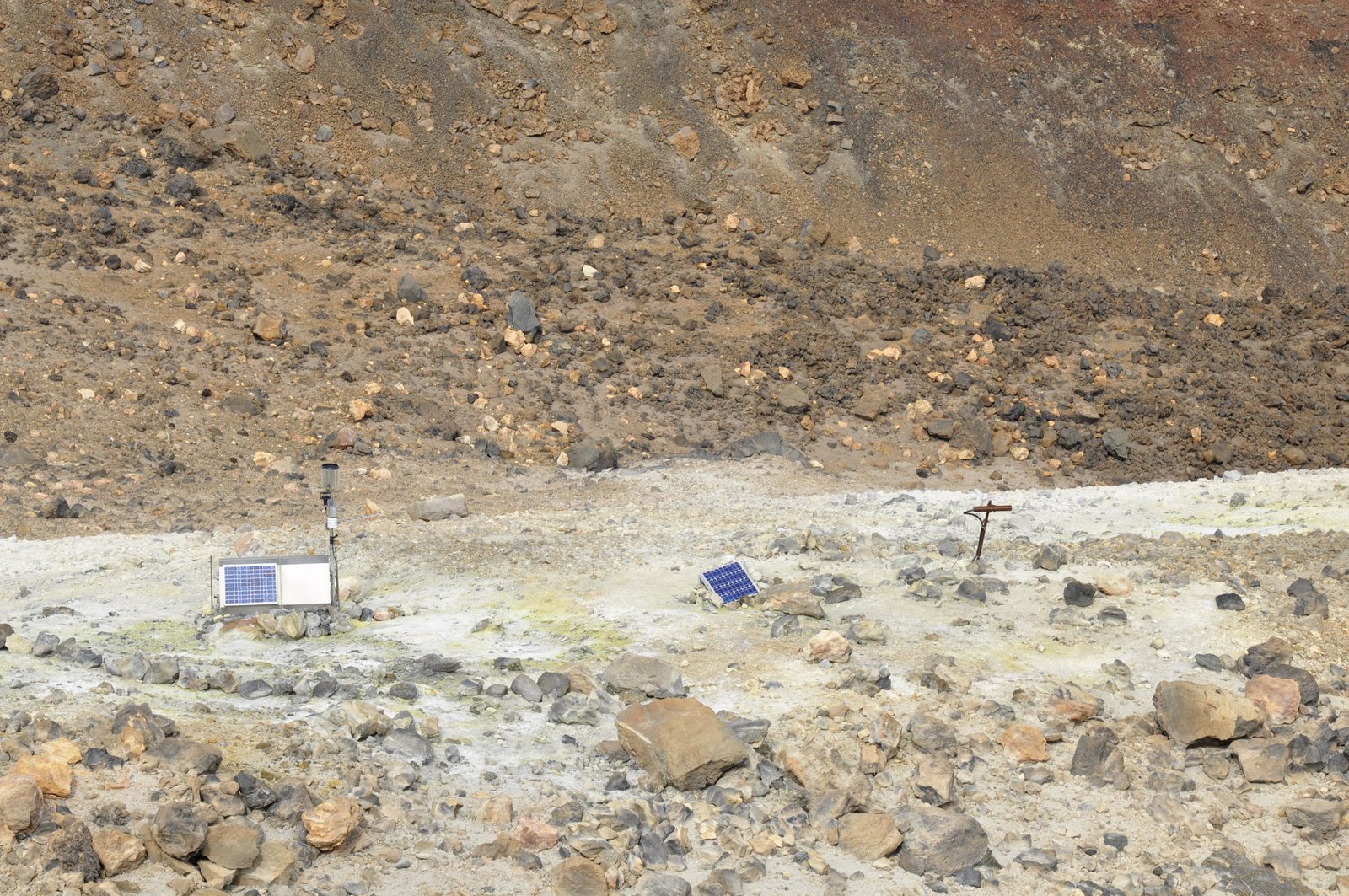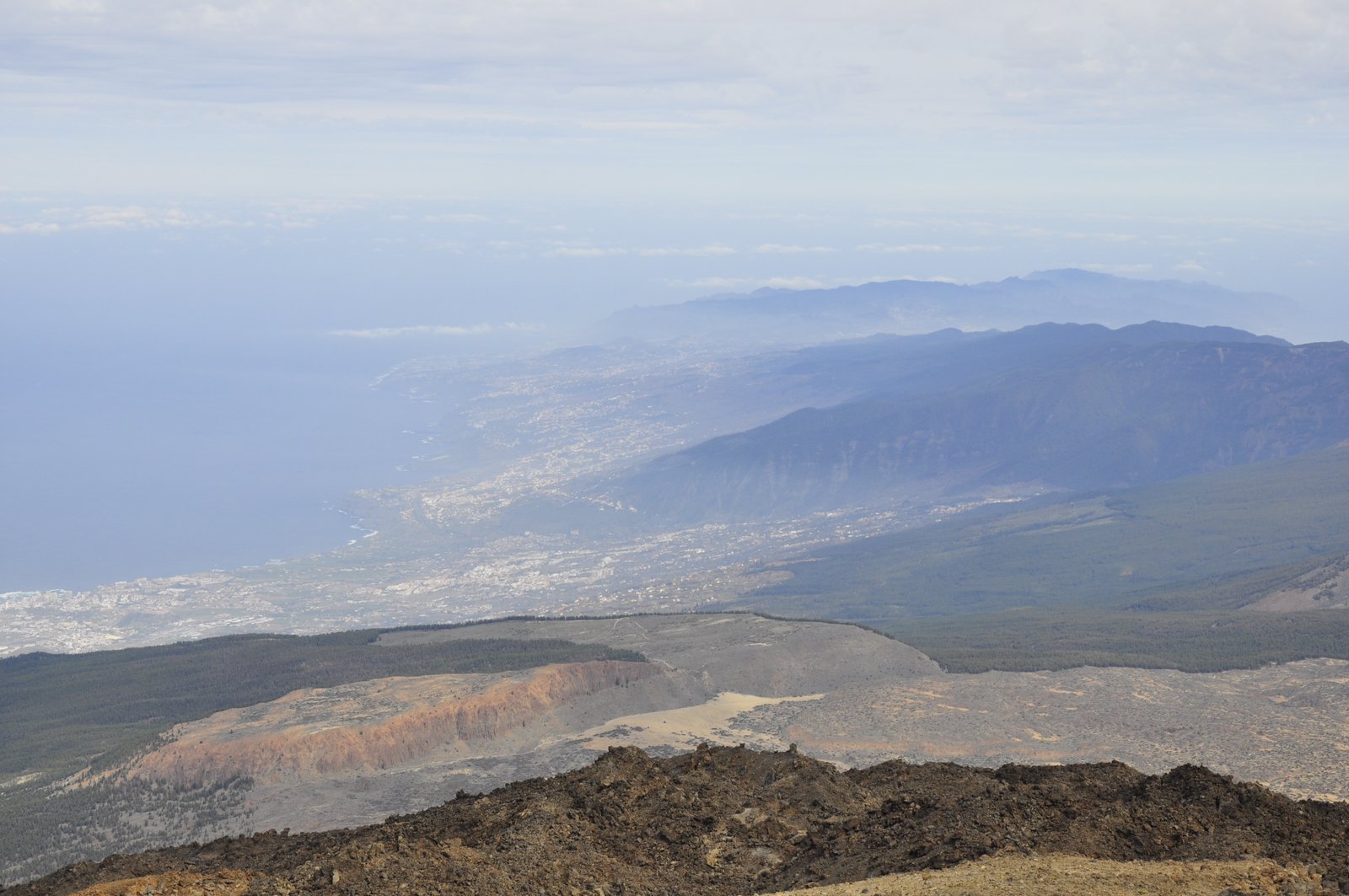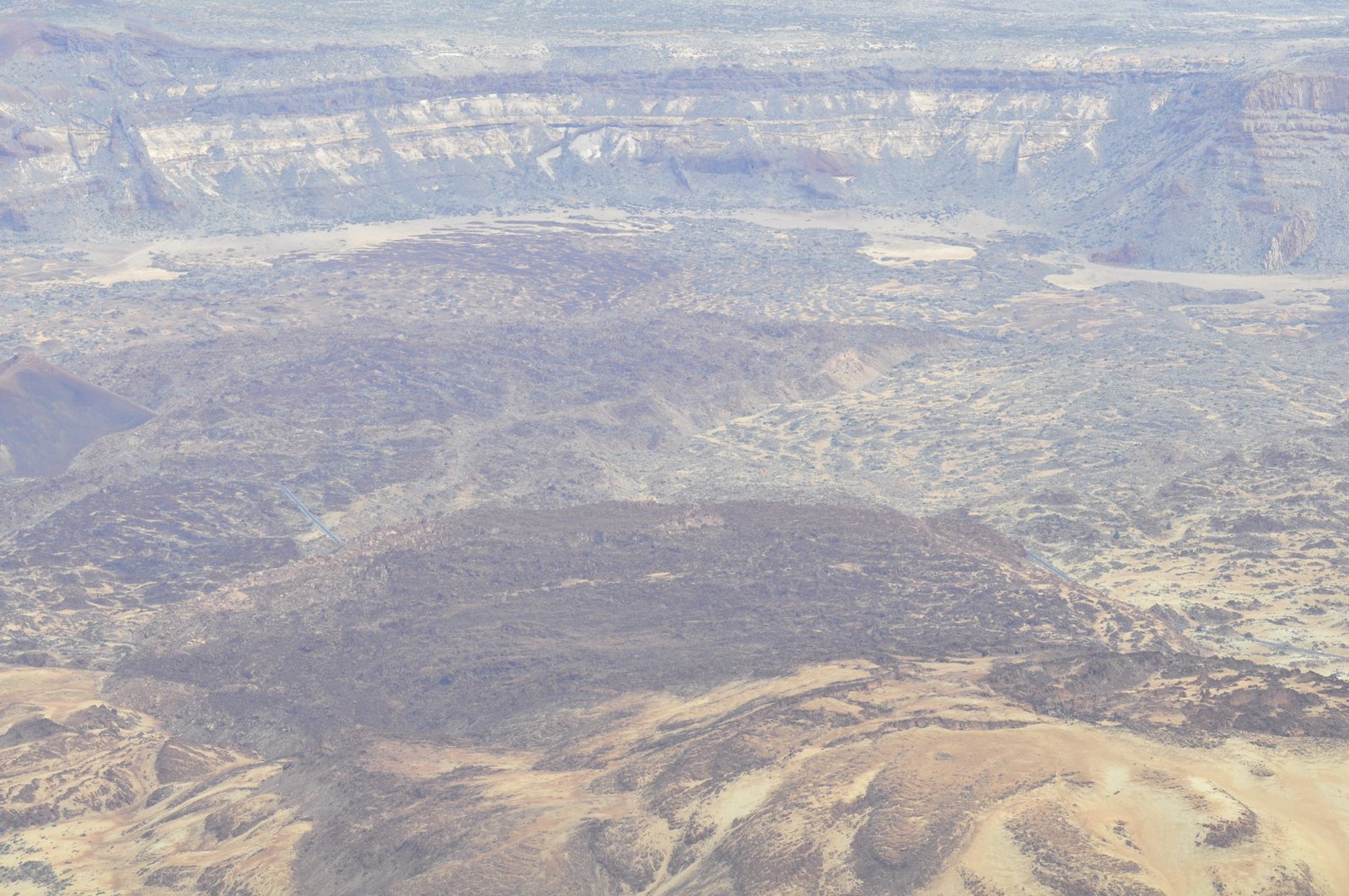The air is cold and thin. I feel it. Walking fast on the path between lava boulders, I need to take a break. A minute to recharge oxygen, another look at the view, at the tiny, tiny towns far, far down there. In the horizon, the dark sihouettes of the neighbour islands. I have been there too, walked steep mountain paths, seen the magificient views from their highest peaks and deep, steep valleys. Now, I look down onto them. They resemble tiny, uneven cookies.
El Pico del Teide supports the sky. A perfect cone, rising into the blue eternity, and a calm, confident, sturdy landmark for seamen. Can I touch space if I raise my hand? Certainly, if I put my hand to the ground in the right place, I can feel the heat from inside the mountain. The heat from Guyaota, the eternal prisoner of El Teide.

Fumaroles on Teide, with some instruments whose purpose I am not sure about. Note how the ground is yellow with sulphur.
3718 meters tall, Teide on the Canary Island Tenerife is the highest mountain in Spain, and the third tallest mountain in the world, if we count from its base. It is 7500 meters down to the seafloor. Only Mauna Loa and Mauna Kea on Hawaii are taller. I recall the feeling from standing on the tops of the neighbor islands, La Gomera and Gran Canaria, and look not across to Teide on Tenerife, but up onto it. The mountain called my geologist heart. I needed to go pilgrimage. Now, the dream came true.
True, it is not exactly an expedition. Five hours by plane, and pick up rental car. The road is marked as “dangerous” on the map, but not worse than some roads in steep Norwegian fjords. It winds up the flank of the enormous edifice, from half-desert into a needle tree forest, then it crawls across the edge of Teide’s big caldera. A panorama of black lava and volcanic ash in fifty shades of brown. Here and there, some bushes. It looks like the landscape from a western movie, mixed with the images rovers send from Mars, and with the layered caldera walls resembling Grand Canyon.
A
From the cable car station at 3550 meters, a path leads towards the top, but to protect the nature, national park authorities limit the number of visitors on the peak each day. To get permission, one must sign up at the net, or hope for a slot at the cable car station office. Except for the thrill of reaching the top, the view is the same. Instead, I choose the other marked paths around on the top. One proceeds towards the north, with a view to the caldera, to Gran Canaria, and the long wedge of Tenerife into the clouds in the north. This path actually goes all the way down the mountainside to the road. At 3260 meters, it passes by the mountain hostel, where die harders and romantic couples stay to watch the sunset from the high.
Another path proceeds southwards along Teide’s flank. At its end is the view towards Gomera, with La Palma as a rounded wedge silhouette further away in the horizon. Halfway down the flank is another crater, and the black lava from the last eruption on Teide.
The Teide of today is the last of many volcanoes on Tenerife. Once upon a time, some twelve million years ago, there were three islands, in what is now the northern, western and southern corners of the triangle island. Through around eight million years, countless volcanic eruptions merged them together. Then, after a couple million years queiscence, Teide grew in the middle, to a volcano even more enormous than today’s peak. Then, the center collapsed and formed the huge bowl that is the caldera. In its middle, the current big cone of Teide rose to the sky.

Looking along the North coast of Tenerife, with Puerto de la Cruz near the sea. If Teide should have a large eruption, Puerto de la Cruz is right in the bull’s eye, and a reason why Teide is one of the specially watched Decade Volcanoes.

The top summit, seen from footpath near the cable car station. Only a Limited number of passes to the top are awarded each day.
The last summit eruption was around year 850, the dark lavas that flow down from the top. Christopher Colombus reportedly saw an eruption on the west coast in 1492, en-route on his bad navigation to “India”. In 1706, Tenrife’s then main port of Garachico was destroyed. The last side vent eruption on Teide in 1789 produced “la lavas negro”, a carpet of black, ropey lava on its south flank. The latest volcano eruption on Tenerife was as late as 1909, at El Chinyero.
Today, Teide is regarded as a dormant volcano. The next eruption could come next year, more likely in a hundred years, or never. Still, Teide is watched closely, and is on the UN list of dangerous “decade volcanoes”, because if a big eruption comes, it could literally blow away Puerto de la Cruz with its 30000 people. A large eruption could also make landslides into the sea, with big tsunamis in the wake. Worst case, it could dispel all of Tenerife’s nearly 900000 people.

The Pico Viejo crater on Teide’s south flank, with La Gomera in the background. Note the big chunk of lava to the left in the crater, the remnant of a lava lake! Four years ago, I stood on the top of Gomera’s highest peak, Alta de Garajonay, looking up onto Teide and decided: I had to go there one day.
Let’s hope Guyaota keeps calm for a while. Let’s hope the devil in the mytology of the Guanches, the original canarians, stays in his prison inside Teide.
Achamán, the eternal and omnipotent god of the Guanches, created land and sky, fire and water, and all things alive. Teide held up the sky above their world. Now and then, Achamán would descend on a mountain top to admire his creation.
But Guyaota, the devil, was jealous. He lived inside Teide, and took the shape of a big, black dog. One day, he kidnapped Magec, the sun god and locked it inside the mountain. Without the sun, darkness fell on Earth. The Guanches prayed to Achamán to relieve them. Achamán set Magec free from Teide, and locked Guyaota inside the mountain forever.
But, Guyaota wants to escape from Teide, and when he tries, the mountains hakes and rattles, and spits fire.
When will be the next time? No-one knows. The sulphurous smell of fart from fumaroles near the cable car station tells us Guyaota is still working on his escape. It could be next year, it could be a thousand, but one day, Teide will again flash its dangerous orange beacon over the sunny islands in the Atlantic Ocean.






Pingback: El Teide, the great impressionist | Adventures in geology - Karsten Eig·
Pingback: Las Canadas caldera: The devil’s cauldron on Tenerife | Adventures in geology - Karsten Eig·
Pingback: The history of Eruptions on Mount Teide - Explore Tenerife·
https://izana.aemet.es/new-radiation-station-at-the-teide-peak-observatory/
When I was there first time in Easter 1975 I think there were some measurements of SO2 and CO2. It was active with some smoke and the top was yellow due to sulphur like it still is.
We’re going the Tuesday. Hopefully the best day of my life.